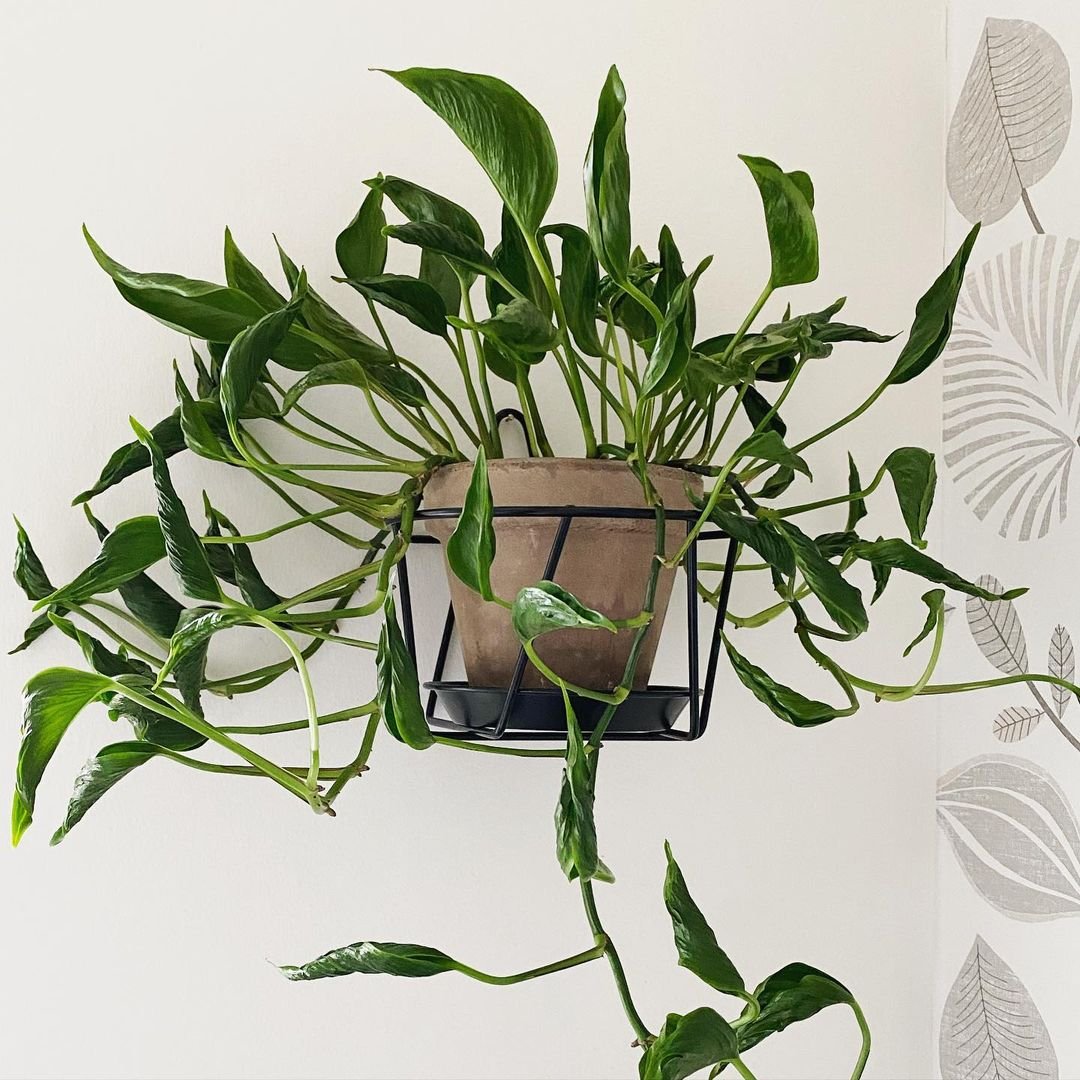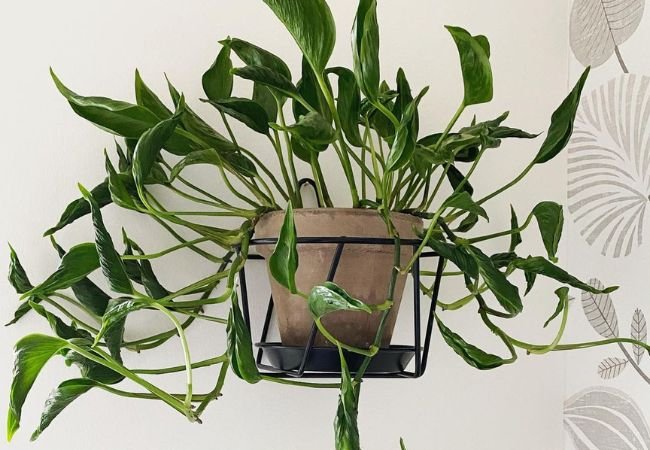Discover essential care tips for your Shangri La Pothos. Learn how to keep this stunning plant healthy and thriving with our comprehensive guide.
Are you looking for a beautiful, easy-to-care-for houseplant? The Shangri La Pothos might be just what you need. This unique variety of pothos is known for its curly, twisted leaves that give it a whimsical appearance. In this guide, we’ll cover everything you need to know about Shangri La Pothos care, from watering to propagation. Let’s dive in and discover how to keep your plant healthy and thriving!
Here’s a short information chart for Shangri La Pothos:
| Attribute | Details |
|---|---|
| Botanical Name | Epipremnum aureum |
| Common Name | Shangri La Pothos |
| Plant Type | Vine |
| Zones | 10-11 (USDA) |
| Sun Exposure | Indirect sunlight to shade |
| Soil Type | Well-draining, fertile soil |
| Watering | Moderate |
| Growth Habit | Climbing |
| Height/Spread | Up to 6 feet tall/spreads |
| Special Features | Air-purifying, Easy-care |
What is Shangri La Pothos?

Shangri La Pothos, also called Epipremnum aureum ‘Shangri La’, is a special type of pothos plant. It’s part of the Araceae family, which includes many popular houseplants. What makes this pothos stand out is its curly, twisted leaves. Unlike the flat leaves of other pothos varieties, Shangri La’s foliage looks like it’s been gently crimped or curled.
This plant is perfect for adding a touch of green to your home or office. It’s not just pretty to look at – it’s also great at cleaning the air! According to a study by NASA, pothos plants can help remove indoor air pollutants.
Light Requirements for Shangri La Pothos
One of the best things about Shangri La Pothos is that it’s not picky about light. It can grow in a range of lighting conditions, from bright indirect light to low light. However, to keep your plant looking its best, here’s what you should know:
- Bright indirect light is ideal. Place your plant near a window with sheer curtains or a few feet away from a bright window.
- Avoid direct sunlight. Too much direct sun can burn the leaves, causing brown spots.
- In low light, the plant will grow more slowly and may lose some of its variegation (light and dark patterns on the leaves).
- If your plant’s leaves are turning yellow, it might be getting too much light. Move it to a slightly shadier spot.
Remember, every home is different. Pay attention to how your plant responds to its environment and adjust as needed.
Watering Your Shangri La Pothos
Watering is a crucial part of Shangri La Pothos care. These plants don’t like to sit in soggy soil, but they also don’t want to dry out completely. Here’s how to get it right:
- Water when the top inch of soil feels dry. Stick your finger into the soil up to the first knuckle. If it’s dry, it’s time to water.
- Use room temperature water. Cold water can shock the plant’s roots.
- Water thoroughly until you see water coming out of the drainage holes. This ensures the entire root ball gets moisture.
- Empty the saucer under the pot after watering. Standing water can lead to root rot.
- In winter, you’ll likely need to water less often as the plant’s growth slows down.
- If the leaves start to droop, it’s usually a sign that the plant needs water.
According to Purdue University, overwatering is one of the most common problems with houseplants. It’s better to underwater slightly than to overwater.
Soil and Potting for Shangri La Pothos
The right soil mix is essential for healthy Shangri La Pothos. These plants prefer well-draining soil that holds some moisture but doesn’t stay soggy. Here’s what you need to know:
- Use a potting mix designed for houseplants. These mixes usually contain peat moss, perlite and sometimes vermiculite.
- You can make your own mix by combining equal parts potting soil, peat moss, and perlite.
- Avoid garden soil for potted plants. It’s too heavy and can lead to drainage problems.
- When potting or repotting, choose a pot with drainage holes. This prevents water from pooling at the bottom.
- Repot your Shangri La Pothos every 1-2 years, or when you notice roots growing out of the drainage holes.
- When repotting, go up one pot size. A pot that’s too big can lead to overwatering issues.
Fertilizing Your Shangri La Pothos
Fertilizer provides the nutrients your Shangri La Pothos needs to grow lush and healthy. Here’s how to fertilize effectively:
- Use a balanced, water-soluble fertilizer. Look for a ratio like 10-10-10 or 20-20-20.
- Fertilize every 4-6 weeks during the growing season (spring and summer).
- Dilute the fertilizer to half the recommended strength. Pothos doesn’t need heavy feeding.
- Don’t fertilize in fall and winter when the plant’s growth slows down.
- If you notice the leaf tips turning brown, you might be over-fertilizing. Flush the soil with plain water and reduce fertilizer application.
According to the University of Florida, over-fertilizing can be as harmful as under-fertilizing. Always follow the instructions on your fertilizer package.
Humidity and Temperature for Shangri La Pothos
Shangri La Pothos is adaptable to average home conditions, but it does have some preferences when it comes to humidity and temperature:
- These plants enjoy moderate to high humidity. Aim for around 50-70% humidity if possible.
- If your home is dry, consider using a humidifier or placing a pebble tray filled with water near the plant.
- Misting the leaves can also help increase humidity, but don’t do this too often as it can lead to fungal issues.
- Shangri La Pothos prefers temperatures between 60-80°F (15-27°C).
- Avoid placing the plant near cold drafts or heating vents, which can cause stress.
- If temperatures drop below 50°F (10°C), the plant’s growth will slow significantly.
Pruning and Maintenance
Regular pruning helps keep your Shangri La Pothos looking its best and encourages bushy growth. Here’s how to prune effectively:
- Trim long vines to encourage branching. Cut just above a leaf node (where a leaf meets the stem).
- Remove any yellow or brown leaves. These aren’t contributing to the plant’s health.
- Use clean, sharp scissors or pruning shears to avoid damaging the plant.
- You can prune at any time of year, but spring and summer are ideal.
- Wipe the leaves with a damp cloth occasionally to remove dust and keep them looking glossy.
- Check regularly for pests like spider mites or mealybugs. If you spot any, treat them promptly with insecticidal soap.
Propagating Shangri La Pothos
One of the joys of Shangri La Pothos is how easy it is to propagate. You can create new plants to keep or share with friends. Here’s how:
- Choose a healthy stem with at least 2-3 leaves.
- Cut the stem just below a leaf node, making the cutting about 4-6 inches long.
- Remove the lower leaves, leaving 1-2 at the top.
- Place the cutting in a jar of water, making sure the leaf nodes are submerged.
- Put the jar in a spot with bright, indirect light.
- Change the water every few days to keep it fresh.
- In about 2-3 weeks, you should see roots developing.
- Once the roots are a couple of inches long, you can plant the cutting in soil.
According to North Carolina State University, pothos is one of the easiest plants to propagate, making it a great choice for beginners.
Common Problems and Solutions
Even with the best care, your Shangri La Pothos might face some issues. Here are some common problems and how to solve them:
- Yellow leaves: Often a sign of overwatering. Let the soil dry out more between waterings.
- Brown leaf tips: This could be due to low humidity or over-fertilizing. Increase humidity and reduce fertilizer.
- Leggy growth: The plant isn’t getting enough light. Move it to a brighter spot.
- Drooping leaves: Usually means the plant needs water. Check the soil and water if it’s dry.
- Pests: Spider mites and mealybugs are common. Treat with insecticidal soap or neem oil.
- Root rot: Caused by overwatering. If caught early, you can save the plant by repotting in fresh, dry soil and reducing watering.
Remember, prevention is better than cure. Regular care and attention can help you spot and address issues before they become serious problems.
Decorating with Shangri La Pothos
Shangri La Pothos isn’t just easy to care for – it’s also a versatile decorative plant. Here are some ideas for showcasing your plant:
- Hanging baskets: The cascading vines look beautiful in a hanging planter.
- Bookshelf decor: Place the plant on a high shelf and let the vines trail down.
- Wall art: Use plant hooks to guide the vines along a wall for a living art piece.
- Bathroom greenery: Shangri La Pothos thrives in the humid bathroom environment.
- Office desk plant: Its air-purifying qualities make it perfect for work spaces.
- Terrarium feature: Use a small Shangri La Pothos as a centerpiece in a terrarium.
Get creative with your placement, but remember to consider the plant’s light needs wherever you put it.
Caring for a Shangri La Pothos can be a rewarding experience. With its unique curly leaves and easy-going nature, this plant is a fantastic choice for both new and experienced plant parents. Remember the key points: provide bright indirect light, water when the top inch of soil is dry, use well-draining soil, and fertilize lightly during the growing season. With these care tips, your Shangri La Pothos will thrive, adding a touch of lush, tropical beauty to your space.
Whether you’re growing your first houseplant or adding to a vast collection, Shangrihttps://bonjourgreen.com/shangri-la-pothos-how-to-grow-and-care/ La Pothos is sure to bring you joy. Its low-maintenance needs and stunning appearance make it a true win-win. So why wait? Start your Shangri La Pothos journey today and enjoy the beauty of this remarkable plant in your home or office. Happy growing!








Leave a Reply